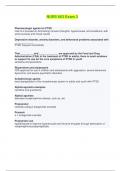NURS 663 Exam 3 Pharmacologic agents for PTSD med tx is focused on diminishing intrusive thoughts, hyperarousal, and avoidance, with some success and mixed results Depressive disorder, anxiety disorders, and behavioral problems associated with ______________ PTSD frequent comorbidity That __________and ______________ are approved by the Food and Drug Administration (FDA) in the treatment of PTSD in adults, there is scant evidence to support its use for the core symptoms of PTSD in youth sertraline and paroxetine Risperidone and aripiprazo le FDA approval for use in children and adolescents with aggression, severe behavioral dyscontrol, and severe psychiatric disorders Antiadrenergic agents treat dysregulation of the noradrenergic system in adults and youth with PTSD Alpha2 -agonists exampl es clonidine and guanfacine Alpha2 agonists decrease norepinephrine release, such as, are Propranolol centrally acting β -antagonists example Prazosin α-1-antagonists example Propranolol use hypothesized to improve hyperarousal and intrusive thoughts through attenuation of norepinephrine postsynaptically nightmares associated with trauma Modify PTSD sx Off-label medications including antidepressants, atypical antipsychotics, adrenergic modulators/ sympatholytics, and anticonvulsants/mood stabilizers Clonidine and propanolol nightmares and exaggerated startle response: some evidence in adults, but children case report only __________ may reduce nightmares in children with PTSD and ____________may diminish symptoms of reenactment of traumatic events in children guanfacine and clonidine Mood -stabilizing agents divalproex, carbamazepine, topiramate, and gabapentin have been utilized for adults with PTSD with modest improvement Clonidine with dosage ranges of 0.05 to 0.1 mg twice daily may provide some relief for the symptoms of hyperarousal, impulsivity, and agitation in young children with PTSD; in children some evidence Benzodiazepines no controlled trials supporting use in children Trauma -Focused CBT 10-16 treatment sessions, including 9 components itemized in the acronym PRACTICE PRACTICE elements Psychoeducation on typical reactions to PTSD. Parenting skills - praise, time -out, reinforcement Relaxation - muscle, breathing, cognitive tech Affective Expression and Modulation - ID feelings Cognitive Coping and Processing Cognitive Triangle Trauma Narrative:developed over time by child, In Vivo Exposure and Mastery of Trauma Reminders - how to deal with reminders Conjoint Child -Parent Sess ions- this component may involve several sessions in which the child and parent share their understanding Enhancing future safety -family changes EMDR exposure and cognitive reprocessing interventions are paired with directed eye movements, alternating ton es or tapping CBITS Cognitive Behavioral Interventions for Trauma in Schools CBITS description intervention that administers treatment in the school setting for children who screen positive for PTSD and whose parents agree to treatment in school. CBITS elements Consists of 10 weekly group sessions 1-3 individual imaginal exposure sessions 2-4 optional sessions with parents 1 parent education session. Similar to trauma -focused CBT, incorporates psychoeducation, relaxation, training, cognitive coping skill s, gradual exposure to traumatic memories SPARCS Structured Psychotherapy for Adolescents Responding to Chronic Stress SPARCS description -Consists of a group intervention, -16 sessions -focus on the needs of adolescents (12 -19 years old) chronic trauma and PTSD. -Utilizes cognitive behavioral techniques, and -incorporates many of the components of TF-CBT -Includes mindfulness techniques and relaxation. TARGET Trauma Affect Regulation: Guide for Education and Therapy TARGET description -affect regulatio n therapy, -combines CBT components, such as cognitive procession, with affect modulation. -adolescents (13 -19) exposed to maltreatment and/or chronic traumatic exposure to such things as community violence or domestic violence. -12 sessions, which focuses on past or current situations. TARGET efficacy --Like SPARCS treatment, gradual exposure may occur in the context of recounting past trauma but is not a core component of treatment. --Reduces anxiety, depression, and PTSD --Promising treatment for girls with h/o delinquency, especially to reduce anger and to enhance optimism and self efficacy. Crisis intervention/Psychological Debriefing 1. several sessions immediately after an exposure to a traumatic event; encouraged to describe the traumatic event in the context of a supportive environment. 2. Psychoeducation is provided and guidance about the management of initial emotional




